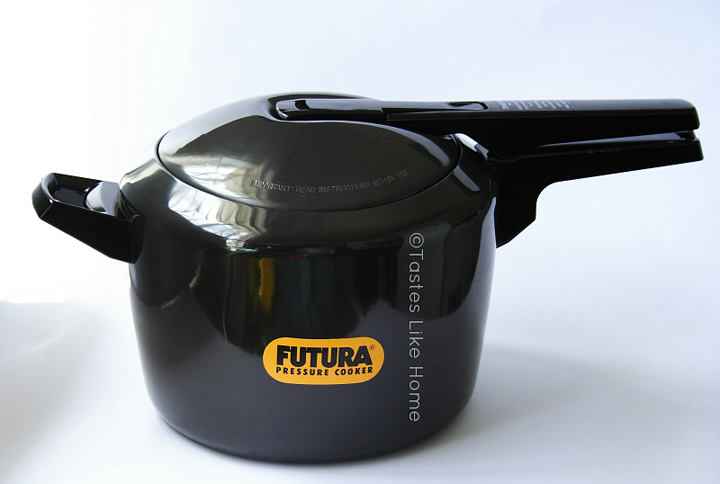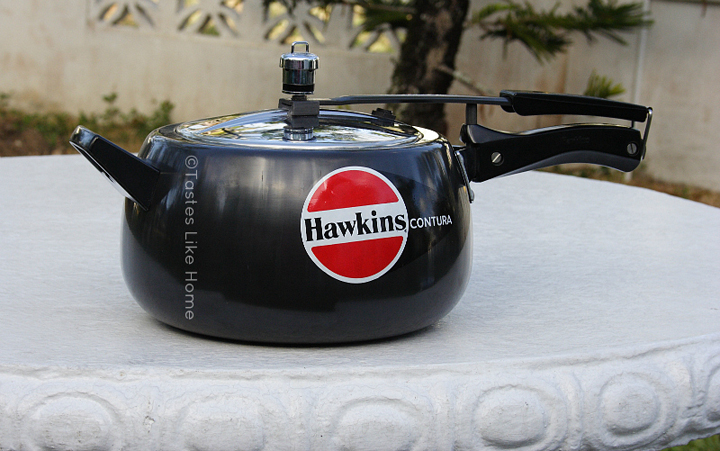Hi Everyone, I have a new baby – a Futura Pressure Cooker, from the makers of the world-class Hawkins cookers! The addition of the Futura now brings the count to 4. I have 4 pressure cookers and I love them all, very much. While I can envisage my kitchen without them, I wouldn’t want to. My latest purchase is not only stunningly beautiful but it also boasts of being the only pressure cooker in the world to have been displayed by The Museum of Modern Art in New York. Well it does have a futuristic look about it in terms of shape, and the hard anodizing material with which it is made definitely speaks to the development of materials that now makes cooking faster.
This week begins a 2-part series on cooking with pressure cookers.
People generally fall into two categories when it comes to pressure cookers – those who cannot imagine life in a kitchen without them and others that steer clear of them. For the latter group, it is all about fear – from bad personal experiences and from the horror stories of others. Before I go any further, let’s address the issue of fear.

PRESSURE COOKING

What is pressure-cooking? Simply put, it is about cooking food in a tightly sealed environment that creates extremely hot steam when heated due to the pressure build-up from the airtight cooking environment. The steam in the intensely heated atmosphere in the cooker penetrates the food, tenderizing it and resulting in the food being cooked quickly. This is the main reason that tougher cuts of meats are cooked in a pressure cooker – for fast tenderization that would otherwise take hours in a regular pot.
I grew up in a house where a pressure cooker was in regular use. My mom would extol the delights of her Hawkins pressure cooker. She’d often boast about having her pressure cooker since I was born. It is not necessary for you to know how long that is! Therefore, for me, when it came to buying my first pressure cooker, about 15 years ago, there was only one brand I was getting – Hawkins. And each pressure cooker, except for one, that I have bought since, has always been Hawkins. I made an exception about 10 years ago and bought a Prestige pressure cooker, which works well but my heart belongs to Hawkins.
When the Hawkins Contura came out I immediately got one. I find the Contura visually pleasing – the body with its rounded sides makes it easier to see all the food in the pot and offers a base for at least ½ litre more in capacity. So when I saw the Futura online, I couldn’t wait to get my hands on one. But I had to wait until I got to Guyana where I knew for sure I’d get one because I couldn’t find the Futura here in Barbados.
A couple of months ago, whilst on a trip to Guyana – to get my Futura among other things – I took the opportunity to sit down with the CEO and Sales Manager, of Auto Supplies company, Brian James and Andrew Kerry, respectively, to talk Hawkins pressure cookers.
This is probably the same for you too… in Guyana, there was really only one place that was synonymous with pressure cookers and specifically Hawkins pressure cookers and that was Auto Supplies Company. As a child I just couldn’t figure out why someone would go to an auto store to buy pressure cookers, of course, I was taking the name of the store literally, never for one moment thinking that it would sell anything else but automobiles and related goods.
At a glance, here’s what Brian James and Andrew Kerry shared with me.
THE COMPANY

Auto Supplies Company (ASCO) has been in existence for over 60 years. The original name of the company was Guyana Pawnbrokers & Trading Company Limited. Auto Supplies became just a call name that stuck given the types of things sold at the store.
For over 50 years, ASCO has been bringing in Hawkins pressure cookers. Most of the products the company brought in for sale were from England and other parts of Europe. ASCO became identified as a company that sold only high quality products.
Hawkins was originally a British brand that was then bought over by a company in India.
There was a lull in business at ASCO in the very late 80s towards the beginning of the 90s and when the company re-opened in 1992, it went in search of the brands for which it had been known over the many years. Unfortunately, many of the brands were no longer in existence but Hawkins was; only now it was not in England but in India. And so ASCO started to bring back the Hawkins line of pressure cookers.
Over the years, ASCO has also been supplying the spare parts necessary for the cookers. That is why, to date, pressure cookers have been enduring in Guyana.
CUSTOMERS
The company (ASCO) never has enough pressure cookers in stock; as fast as they come in, they are gone. There is a constant demand for pressure cookers.
The customer base is a knowledgeable one. In other words, most customers already own pressure cookers or are familiar with using pressure cookers.
Long ago most homes only had 1 pressure cooker, these days people are buying multiple pressure cookers in varying sizes.
The pressure cooker is under-utilised; most people only use it for curries, stews and soups. The pressure cooker can be used for so much more.
After reading the accompanying manual for recipes and ideas, one will find him or herself using the pressure cooker every day.
People are not generally aware of the different types of pressure cookers; it’s not just a one-size fits all. There are different materials, shapes and sizes.
PRESSURE COOKERS
The various sizes and shapes of pressure cookers relate to how one cooks and uses one’s pressure cooker. For example, the Contura works well with the shape of a spoon and makes for easy stirring.
Pressure cookers are made from 3 types of materials – aluminium, stainless steel and hard anodizing. Hard anodizing is a process used to create a hardwearing, corrosion resistant coating on a variety of metals. This process provides a surface harder than steel with amazing properties for cooking. This is the technology used on Hawkins cookers such as the Futura line.
Before purchasing, indicate to the sales representative the type of cooktop you have – gas, electric or induction so that he or she will be able to advise you as to the cooker made of the type of material compatible with your cooktop. For example, aluminium does not heat up on an induction cooktop.
The inside of an aluminium pressure cooker has a matted type of silver while the outsides are buffed to look shiny.
On the other hand, with a stainless steel pressure cooker, the insides and the outsides are bright and shiny.
The cooking times when using an aluminium or stainless steel are pretty much the same, but the Futura, made of the hard anodizing materials heats and cooks up faster.
The shiny surface of the Futura black pressure cookers is as a result of a special coating of the material called satilon. This coating is not only attractive and lasts a very long time but it helps protect against grease, scratches and stains.
Next week I will conclude this 2-part series looking at the benefits of pressure-cooking, how my Futura is working, and some do’s and don’ts when using a pressure cooker.
Cynthia





